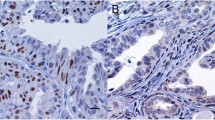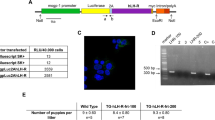Abstract
Using medroxyprogesterone acetate (MPA) as a carcinogen, we were able to induce in BALB/c female mice, several progestin-dependent mammary ductal carcinomas that regress completely with estrogen or antiprogestins and are maintained by serial transplantations in syngeneic mice. Progestin-independent variants were subsequently generated or appeared spontaneously. Based on their response to estrogen or antiprogestins, we subdivided them into responsive progestin-independent (R-PI) variants which regress completely and unresponsive progestin-independent (UR-PI) carcinomas which are resistant to both families of compounds. In this study we have investigated progesterone receptor (PR) expression in six responsive progestin-dependent, six R-PI, and three UR-PI tumors. Progestin-dependent and R-PI tumors disclosed a higher expression of the PRA isoform as compared with PRB, as well as an additional band of 78 kDa that was not detected in uterine tissue; all were down-regulated by progestins. UR-PI tumors expressed lower levels of all bands in western blots, but were highly reactive by immunohistochemistry. PR RNA expression was detected in both, UR-PI and R-PI tumors. PR binding was comparable in progestin-dependent and R-PI tumors. In the three UR-PI tumors, only 29/61 (48%) of the samples evaluated showed low binding levels, the rest were negative. This report is the first to describe in an experimental model of breast cancer the expression of PR isoforms and their distribution. Our results suggest the expression of functionally altered isoforms in a subgroup of mammary carcinomas, which may explain their lack of hormone response.
Similar content being viewed by others
References
Harris JR, Lippman ME, Veronesi U, Willett W: Breast cancer (1). N Engl J Med 327: 319-328, 1992
Tonetti DA, Jordan VC: Possible mechanisms in the emergence of tamoxifen-resistant breast cancer. Anticancer Drugs 6: 498-507, 1995
Clarke R, Brünner N: Acquired estrogen independence and antiestrogen resistance in breast cancer. Estrogen receptor driven phenotypes?. Trends Endocrinol Metabiol 7: 291-301, 1996
Ross RK, Paganini-Hill A, Wan PC, Pike MC: Effect of hormone replacement therapy on breast cancer risk: estrogen versus estrogen plus progestin. J Natl Cancer Inst 92: 328-332, 2000
Women's Health Initiative: Risks and benefits of estrogen plus progestin in healthy postmenopausal women: principal results from theWomen's Health Initiative randomized controlled trial. JAMA 288: 321-333, 2002
Tsai MJ, O'Malley BW: Molecular mechanisms of action of steroid/thyroid receptor superfamily members. Annu Rev Biochem 63: 451-486, 1994
Beato M: Transcriptional control by nuclear receptors. FASEB J 5: 2044-2051, 1991
Horwitz KB, Jackson TA, Bain DL, Richer JK, Takimoto GS, Tung L: Nuclear receptor coactivators and corepressors. Mol Endocrinol 10: 1167-1177, 1996
Horwitz KB, Wei LL, Francis MD: Structural analyses of progesterone receptors. J Steroid Biochem 24: 109-117, 1986
Wen DX, Xu YF, Mais DE, Goldman ME, McDonnell DP: The A and B isoforms of the human progesterone receptor operate through distinct signaling pathways within target cells. Mol Cell Biol 14: 8356-8364, 1994
Richer JK, Jacobsen BM, Manning NG, Abel MG, Wolf DM, Horwitz KB: Differential gene regulation by the two progesterone receptor isoforms in human breast cancer cells. J Biol Chem 277: 5209-5218, 2002
Lessey BA, Alexander PS, Horwitz KB: The subunit structure of human breast cancer progesterone receptors: characterization by chromatography and photoaffinity labeling. Endocrinology 112: 1267-1274, 1983
Graham JD, Yeates C, Balleine RL, Harvey SS, Milliken JS, Bilous AM, Clarke CL: Characterization of progesterone receptor A and B expression in human breast cancer. Cancer Res 55: 5063-5068, 1995
Bamberger AM, Milde-Langosch K, Schulte HM, Loning T: Progesterone receptor isoforms, PR-B and PR-A, in breast cancer: correlations with clinicopathologic tumor parameters and expression of AP-1 factors. Horm Res 54: 32-37, 2000
Shyamala G, Schneider W, Schott D: Developmental regulation of murine mammary progesterone receptor gene expression. Endocrinology 126: 2882-2889, 1990
Schneider W, Ramachandran C, Satyaswaroop PG, Shyamala G: Murine progesterone receptor exists predominantly as the 83-kilodalton ‘A’ form. J Steroid Biochem Mol Biol 38: 285-291, 1991
Shyamala G, Yang X, Silberstein G, Barcellos-Hoff MH, Dale E: Transgenic mice carrying an imbalance in the native ratio of A to B forms of progesterone receptor exhibit developmental abnormalities in mammary glands. Proc Natl Acad Sci USA 95: 696-701, 1998
Mulac-Jericevic B, Mullinax RA, DeMayo FJ, Lydon JP, Conneely OM: Subgroup of reproductive functions of progesterone mediated by progesterone receptor-B isoform. Science 289: 1751-1754, 2000
Lanari C, Molinolo AA, Pasqualini CD: Induction of mammary adenocarcinomas by medroxyprogesterone acetate in BALB/c female mice. Cancer Lett 33: 215-223, 1986
Molinolo AA, Lanari C, Charreau EH, Sanjuan N, Pasqualini CD: Mouse mammary tumors induced by medroxyprogesterone acetate: immunohistochemistry and hormonal receptors. J Natl Cancer Inst 79: 1341-1350, 1987
Kordon E, Lanari C, Molinolo AA, Elizalde PV, Charreau EH, Pasqualini CD: Estrogen inhibition of MPA-induced mouse mammary tumor transplants. Int J Cancer 49: 900-905, 1991
Kordon EC, Molinolo AA, Pasqualini CD, Charreau EH, Pazos P, Dran G, Lanari C: Progesterone induction of mammary carcinomas in BALB/c female mice. Correlation between progestin dependence and morphology. Breast Cancer Res Treat 28: 29-39, 1993
Kordon E, Lanari C, Meiss R, Charreau E, Pasqualini CD: Hormone dependence of a mouse mammary tumor line induced in vivo by medroxyprogesterone acetate. Breast Cancer Res Treat 17: 33-43, 1990
Montecchia MF, Lamb C, Molinolo AA, Luthy IA, Pazos P, Charreau E, Vanzulli S, Lanari C: Progesterone receptor involvement in independent tumor growth in MPA-induced murine mammary adenocarcinomas. J Steroid Biochem Mol Biol 68: 11-21, 1999
Costa SD, Lange S, Klinga K, Merkle E, Kaufmann M: Factors influencing the prognostic role of oestrogen and progesterone receptor levels in breast cancer-results of the analysis of 670 patients with 11 years of follow-up. Eur J Cancer 38: 1329-1334, 2002
Institute of Laboratory Animal Resources, Commission on Life Sciences National Research Council: Guide for the Care and Use of Laboratory Animals. National Academy Press, Washington, DC, 1996.
Lanari C, Kordon E, Molinolo A, Pasqualini CD, Charreau EH: Mammary adenocarcinomas induced by medroxyprogesterone acetate: hormone dependence and EGF receptors of BALB/c in vivo sublines. Int J Cancer 43: 845-850, 1989
Kordon EC, Guerra F, Molinolo AA, Charreau EH, Pasqualini CD, Pazos P, Dran G, Lanari C: Effect of sialoadenectomy on medroxyprogesterone-acetate-induced mammary carcinogenesis in BALB/c mice. Correlation between histology and epidermal-growth-factor receptor content. Int J Cancer 59: 196-203, 1994
Lydon JP, DeMayo FJ, Funk CR, Mani SK, Hughes AR, Montgomery Jr. CA, Shyamala G, Conneely OM, O'Malley BW: Mice lacking progesterone receptor exhibit pleiotropic reproductive abnormalities. Genes Dev 9: 2266-2278, 1995
Lowry OH, Rosebrough NJ, Farr AL: Protein measurements with the Folin phenol reagent. J Biol Chem 193: 265-275, 1951
Laemmli UK: Cleavage of structural proteins during the assembly of the head of bacteriophage T4. Nature 227: 680-685, 1970
Clarke CL, Zaino RJ, Feil PD, Miller JV, Steck ME, Ohlsson-Wilhelm BM, Satyaswaroop PG: Monoclonal antibodies to human progesterone receptor: characterization by biochemical and immunohistochemical techniques. Endocrinology 121: 1123-1132, 1987
Yeates C, Hunt SM, Balleine RL, and Clarke CL: Characterization of a truncated progesterone receptor protein in breast tumors. J Clin Endocrinol Metabiol 83: 4600-4607, 1998
Shyamala G, Barcellos-Hoff MH, Toft D, Yang X: In situ localization of progesterone receptors in normal mousemammary glands: absence of receptors in the connective and adipose stroma and a heterogeneous distribution in the epithelium. J Steroid Biochem Mol Biol 63: 251-259, 1997
Silberstein GB, Van Horn K, Shyamala G, Daniel CW: Progesterone receptors in the mouse mammary duct: distribution and developmental regulation. Cell Growth Diff 7: 945-952, 1996
Chomczynski P, Sacchi N: Single-step method of RNA isolation by acid guanidinium thiocyanate-phenol-chloroform extraction. Anal Biochem 162: 156-159, 1987
Schott DR, Shyamala G, Schneider W, Parry G: Molecular cloning, sequence analyses, and expression of complementary DNA encoding murine progesterone receptor. Biochemistry 30: 7014-7020, 1991
Weigel NL: Steroid hormone receptors and their regulation by phosphorylation. Biochem J 319: 657-667, 1996
Palmieri C, Cheng GJ, Saji S, Zelada-Hedman M, Warri A, Weihua Z, Van Noorden S, Wahlstrom T, Coombes RC, Warner M, Gustafsson JA: Estrogen receptor beta in breast cancer. Endocr Relat Cancer 9: 1-13, 2002
Castoria G, Migliaccio A, Bilancio A, Pagano M, Abbondanza C, Auricchio F: A 67 kDa non-hormone binding estradiol receptor is present in human mammary cancers. Int J Cancer 65: 574-583, 1996
Migliaccio A, Pagano M, de Goeij CC, Di Domenico M, Castoria G, Sluyser M, Auricchio F: Phosphorylation and estradiol binding of estrogen receptor in hormone-dependent and hormone-independent GR mouse mammary tumors. Int J Cancer 51: 733-739, 1992
Peethambaram PP, Ingle JN, Suman VJ, Hartmann LC, Loprinzi CL: Randomized trial of diethylstilbestrol vs. tamoxifen in postmenopausal women with metastatic breast cancer. An updated analysis. Breast Cancer Res Treat 54: 117-122, 1999
Brunner N, Spang-Thomsen M, Cullen K: The T61 human breast cancer xenograft: an experimental model of estrogen therapy of breast cancer. Breast Cancer Res Treat 39: 87-92, 1996
Chisamore MJ, Ahmed Y, Bentrem DJ, Jordan VC, Tonetti DA: Novel antitumor effect of estradiol in athymic mice injected with a T47D breast cancer cell line overexpressing protein kinase Calpha. Clin Cancer Res 7: 3156-3165, 2001
Levenson AS, Jordan VC: Transfection of human estrogen receptor (ER) cDNA into ER-negative mammalian cell lines. J Steroid Biochem Mol Biol 51: 229-239, 1994
Zajchowski DA, Sager R, Webster L: Estrogen inhibits the growth of estrogen receptor-negative, but not estrogen receptor-positive, human mammary epithelial cells expressing a recombinant estrogen receptor. Cancer Res 53: 5004-5011, 1993
Lantinga-van Leeuwen IS, van Garderen E, Rutteman GR, Mol JA: Cloning and cellular localization of the canine progesterone receptor: co-localization with growth hormone in the mammary gland. J Steroid Biochem Mol Biol 75: 219-228, 2000
Lamb C, Simian M, Molinolo A, Pazos P, Lanari C: Regulation of cell growth of a progestin-dependent murine mammary carcinoma in vitro: progesterone receptor involvement in serum or growth factor-induced cell proliferation. J Steroid Biochem Mol Biol 70: 133-142, 1999
Author information
Authors and Affiliations
Rights and permissions
About this article
Cite this article
Helguero, L.A., Viegas, M., Asaithamby, A. et al. Progesterone Receptor Expression in Medroxyprogesterone Acetate-Induced Murine Mammary Carcinomas and Response to Endocrine Treatment. Breast Cancer Res Treat 79, 379–390 (2003). https://doi.org/10.1023/A:1024029826248
Issue Date:
DOI: https://doi.org/10.1023/A:1024029826248




